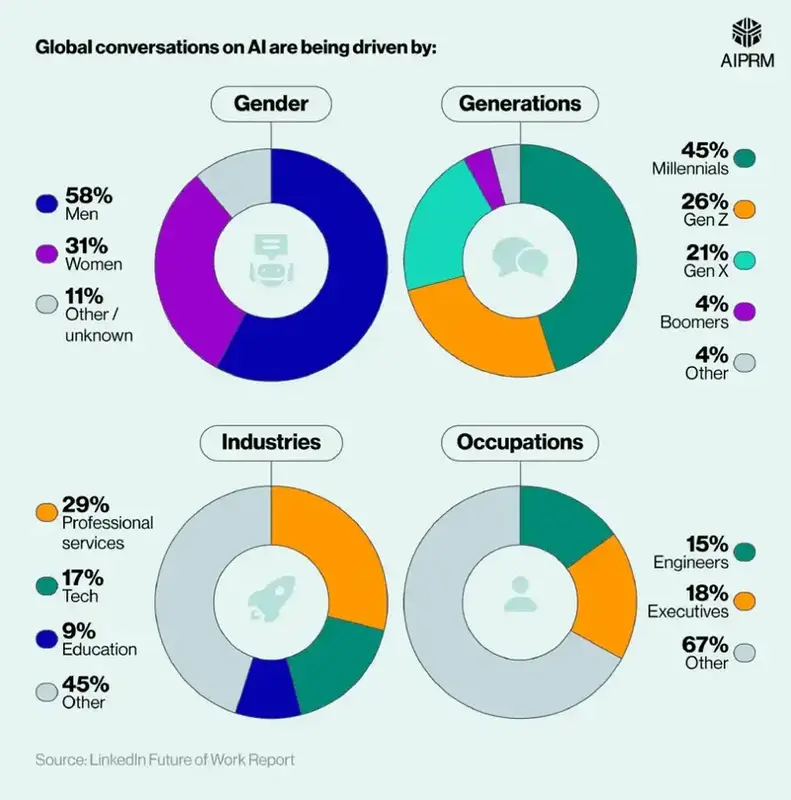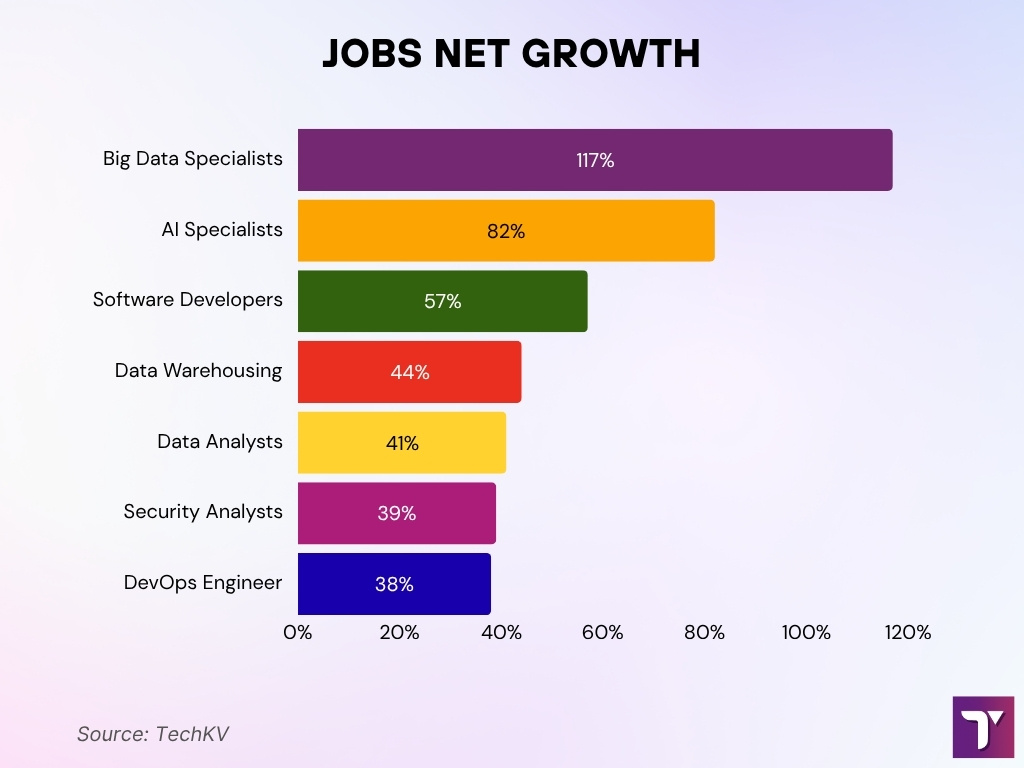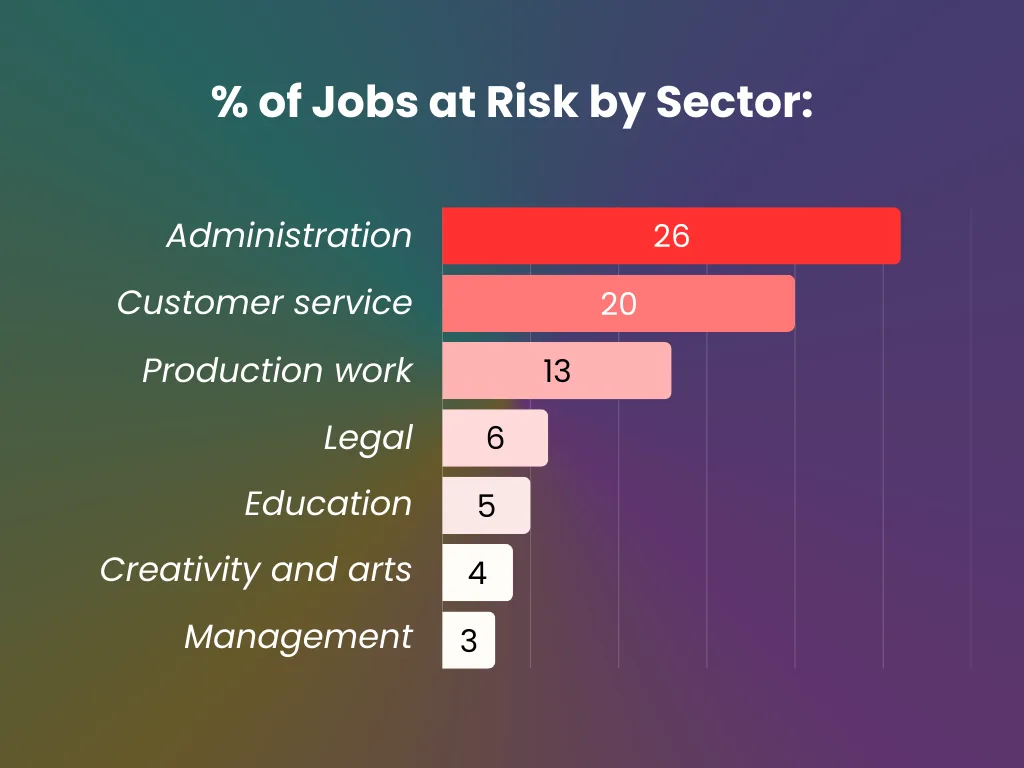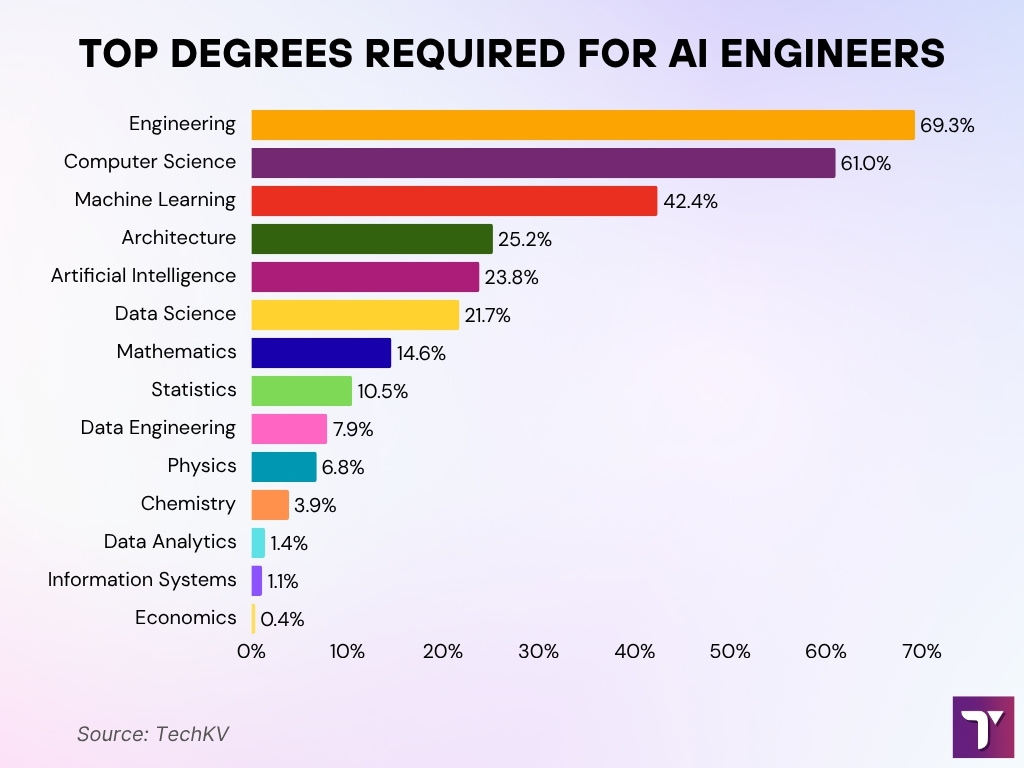The rise of artificial intelligence (AI) is no longer just a technology trend; it’s a workforce revolution. From reshaping healthcare diagnostics to optimizing logistics, AI is driving productivity while transforming the nature of jobs across industries. In finance, AI algorithms are creating new roles in fraud detection and automated advisory services, while in manufacturing, smart robotics are enabling leaner operations and better quality control. As AI’s influence deepens, it’s creating millions of new career pathways.
Editor’s Choice
- 170 million new jobs will be created by AI by 2030, while 92 million will be displaced, resulting in a net gain of 78 million jobs globally.
- In Q1 2025, over 35,000 AI-related jobs were posted in the U.S., aligning with continued growth tracked by CompTIA and LinkedIn’s job market reports.
- Roles requiring AI skills now offer a 56% wage premium, more than double compared to 2022.
- 85% of global employers plan to adopt upskilling strategies to meet AI-related demands by 2030.
- AI technologies affect 2–3 times more female-dominated jobs than male-dominated ones in high-income economies, according to IMF and WEF estimates, with variation by occupation type and sector.
- Prompt Engineer roles are among the fastest-growing in 2025, with top salaries ranging from $250,000 to $335,000/year at leading firms like Anthropic and Netflix.
- Job postings with Generative AI components show a 36–37% increase in cognitive skill requirements, especially in problem-solving and adaptability.
Recent Developments
- AI job postings in the U.S. grew by 25.2% year-over-year in Q1 2025.
- As of early 2025, median U.S. AI salaries are estimated between $145,000–$160,000, depending on role and location.
- AI Prompt Engineer tops the list of high-growth titles, commanding up to $335,000/year.
- Roles with generative AI components are demanding 36.7% more cognitive skills post-ChatGPT.
- Companies using GenAI are increasing the demand for social skills by 5.2%.
- Skills required for AI-exposed jobs are evolving 66% faster than non-AI roles.
- Job replacement fears persist; 30% of U.S. workers worry about losing their jobs to AI.
- Human-AI collaboration is growing, especially in creative, healthcare, and decision-making roles.
- “Human-AI hybrid” positions are emerging in compliance, ethics, and quality assurance.
Who’s Driving the Global AI Conversation?
- 58% of global AI discussions are led by men, while 31% come from women, and 11% from other or unknown sources.
- Millennials are the most active generation, contributing 45% of all AI-related conversations.
- Gen Z makes up 26%, followed by Gen X at 21%, and Boomers and Other generations at 4% each.
- By industry, Professional services lead with 29% of AI discussions.
- The Tech sector follows with 17%, and Education contributes 9%.
- Other industries make up the remaining 45% of AI-related dialogue.
- By occupation, Executives account for 18% of conversations, and Engineers contribute 15%.
- The remaining 67% come from a diverse mix of other roles.

General Impact of AI on Job Creation
- The World Economic Forum projects a net gain of 78 million jobs globally through AI by 2030.
- AI’s economic impact is forecasted to contribute $15.7 trillion to the global economy by 2030.
- Over 85 million jobs may be displaced due to AI, but new roles will replace and exceed these losses.
- AI-exposed jobs are experiencing 2x faster wage growth than non-AI-exposed roles.
- AI contributes to 56% higher wages for roles with AI skill requirements.
- Generative AI tools like ChatGPT have already created thousands of content, marketing, and customer service roles.
- Automation is shifting focus from task completion to augmentation and decision support.
- Human-AI collaboration models are rising in adoption across sectors like education, healthcare, and law.
- The number of AI startups has surged, contributing to job creation in early-stage tech ecosystems.
- AI is enhancing productivity, indirectly driving job demand in supporting roles like data annotation, system integration, and change management.
AI-Driven Workforce Growth Trends
- U.S. AI-related job postings grew 25.2% YoY in Q1 2025.
- AI roles now account for 4.2% of total tech job listings, up from 3.1% last year.
- AI-related positions in healthcare, such as AI medical imaging analysts, are expanding rapidly.
- Finance and insurance sectors saw a 17% growth in AI roles in the last 12 months.
- The top sectors for AI jobs are: IT services, healthcare, finance, manufacturing, and retail.
- AI project manager roles are seeing a 19% annual growth rate in demand.
- Retail companies are hiring AI specialists to manage dynamic pricing, inventory, and personalization.
- AI engineering roles dominate tech hiring, especially in NLP and vision systems.
- Many non-tech companies are creating dedicated internal AI teams to lead transformation.
- The average time-to-hire for AI roles has shortened, signaling urgent demand.
Fastest-Growing Tech Jobs
- Big Data Specialists top the chart with a projected 117% increase in job demand from 2025 to 2030.
- AI Specialists follow with an 82% growth rate, underscoring the rapid expansion of artificial intelligence adoption.
- Software Developers are expected to grow by 57%, fueled by accelerating digital transformation initiatives.
- Data Warehousing Professionals will see a 44% net increase, reflecting the need for large-scale data management.
- Data Analysts are projected to grow by 41%, driven by demand for data-driven insights.
- Security Analysts will experience a 39% rise, pointing to heightened cybersecurity priorities.
- DevOps Engineers round out the list with a 38% increase, as automation and cloud infrastructure continue to expand.

Fastest-Growing AI-Related Roles
- AI Prompt Engineer roles surged in demand in 2025, offering salaries up to $335,000/year.
- Machine Learning Engineer remains a staple, with an estimated 23% YoY job growth.
- AI Ethicist roles are increasing as firms prioritize responsible AI use.
- AI Trainers and Data Labeling Specialists are in demand for fine-tuning large models.
- Conversational AI Designer is emerging in the marketing and customer experience sectors.
- Computer Vision Engineers are crucial in retail, manufacturing, and autonomous tech.
- AI in Cybersecurity roles is expanding rapidly due to growing threat landscapes.
- AI Product Managers combine domain expertise with AI strategy.
Geographic Patterns in AI Job Creation
- AI-exposed industries in high-income economies are seeing wages grow twice as fast as in less AI-exposed sectors.
- 100% of industries, including traditional sectors, plan to increase AI usage.
- In the U.S., metro hubs like Philadelphia reported 378 AI job postings in January 2025.
- 86% of employers globally expect AI technologies to transform their operations by 2030.
- Only 29% of businesses believe talent availability will improve over the next five years.
- 37% of companies cite lack of industry appeal as a hiring barrier, 27% cite internal issues.
- In lower-income economies, 82% to 87% of firms emphasize upskilling as a workforce strategy.
- AI wage premiums (56%) are visible across sectors and geographies.
- North America, Europe, and parts of Asia dominate AI job creation, particularly in ICT sectors.
Job Sectors Most Vulnerable to Automation
- Administrative roles are most at risk, with 26% of jobs threatened by automation and AI tools.
- Customer service jobs follow, with 20% facing potential technological disruption.
- Production work ranks third, with 13% of roles at risk due to machinery and robotics.
- The legal sector faces a 6% risk, especially in repetitive or clerical functions.
- Education roles carry a relatively low 5% risk, due to their human-centered nature.
- Jobs in creativity and the arts have only a 4% risk, highlighting AI’s limits in emotional and original expression.
- Management positions are the least affected, with just a 3% risk, as strategic thinking and leadership remain human strengths.

Education and Skills Needed for AI Jobs
- Skills for AI-exposed jobs are evolving 66% faster than for other roles.
- Roles with AI skills offer a 56% wage premium, more than double that of 2022.
- Degree requirements for AI roles fell from 66% to 59% between 2019 and 2024.
- For automatable roles, degree demand dropped from 53% to 44%.
- GenAI job ads demand 36.7% more cognitive skills, 5.2% more social skills.
- Human-centric skills (e.g., teamwork, adaptability) grow 50% faster than technical skills.
- Nontechnical traits like empathy and communication are now key in AI hiring.
- Demand is rising for hybrid skills: AI + healthcare, finance, or legal expertise.
- 94% of employees and 99% of C-suite report familiarity with GenAI tools.
Impact by Generation
- 56% of Millennials use AI at work, compared to 25% of Baby Boomers.
- 13% of employees report using GenAI for 30%+ of their daily tasks.
- 34% of employees expect to reach 30% GenAI use within a year.
- 39% of employees are “AI optimists” or “Bloomers”.
- 39% of skills are projected to become obsolete within five years.
- Workers aged 18–24 are 129% more likely than those over 65 to fear AI job loss.
- 30% of U.S. workers fear AI replacement by 2025.
- Standard productivity software integrations are closing generational gaps in AI use.
Most In-Demand Degrees for AI Engineering Roles
- Engineering leads the field, appearing in 69.3% of all AI engineer job postings.
- Computer Science is mentioned in 61.0% of listings, signaling strong demand for core technical expertise.
- Machine Learning degrees are cited in 42.4% of roles, showing increasing specialization in the field.
- Architecture (focused on systems thinking) is listed in 25.2% of descriptions, beyond just building design.
- Artificial Intelligence is directly mentioned in 23.8% of job postings.
- Data Science is relevant in 21.7% of roles, emphasizing analytical and modeling skills.
- Mathematics is valued in 14.6% of positions for foundational knowledge.
- Statistics appear in 10.5%, particularly useful for data modeling and predictive systems.
- Data Engineering is required in 7.9% of listings, reflecting the need for large-scale data pipeline management.
- Physics (6.8%) and Chemistry (3.9%) show up in niche applications like scientific computing or material simulations.
- Complementary fields include Data Analytics (1.4%), Information Systems (1.1%), and Economics (0.4%).

AI Job Impact by Gender
- AI is transforming 9.6% of female-dominated jobs versus 3.5% of male-dominated roles.
- Women disproportionately occupy more AI-exposed positions across countries.
- Women hold only 35% of U.S. tech jobs and under one-third of global tech leadership roles.
- GenAI hiring data shows callback rates favor men in high-wage roles.
- Women are 22% less likely than men to use GenAI tools.
- 63% of women using AI say they lack proper training to fully utilize it.
- 45% of U.S. workers report using AI, but usage is uneven across genders.
- Gender disparities persist in AI training access unless proactively addressed.
Workforce Upskilling
- 85% of employers plan to upskill workers for AI between 2025–2030.
- Upskilling strategy adoption is 87% in high-income and 82% in low/mid-income economies.
- Only 4% of employers provide upskilling in the first two years of employment.
- 94% of employees and 99% of leaders know GenAI, but usage is often underestimated.
- Over 70% of employees believe GenAI can enhance creativity and skills.
- 51% of workers say better training is critical to improve AI outcomes.
- Companies use “Buy, Build, or Bot” models for talent strategy.
- 47% of firms plan AI tech integration, only 31% align workforce planning.
- AI-exposed industries see 2× wage growth, signaling ROI from skill investments.
Net Employment Gains from AI Technologies
- 170 million new roles are expected globally by 2030, offset by 92 million displaced jobs.
- AI may displace 6–7% of the U.S. workforce, with new jobs absorbing losses.
- $156,998 is the median U.S. AI salary in Q1 2025.
- 85 million jobs worldwide may be replaced by automation in the next decade.
- AI job creation may scale from 4.77 million to 12.97 million annually by 2030.
- 27% of firms have used AI to replace jobs recently.
- Occupations with high AI exposure saw larger increases in unemployment rates.
- Generative systems are targeting replicable tasks more than strategic roles.
Human-AI Collaboration Careers
- LLMs are increasingly designed to collaborate with human actors.
- The WORKBank model classifies jobs into augment, automate, and elevate zones.
- Human-complementary skills grow 50% faster than substitutable ones.
- Most firms are still integrating AI at early stages, human oversight remains critical.
- Generative AI supports ideation and summarization, while humans retain decision authority.
- Ethical AI roles are expanding rapidly.
- Human-AI workflows are replacing purely automated or manual roles.
- Future careers will blend technical fluency with human strengths.
Future-Proof Careers in the Age of AI
- Emotionally intelligent, ethical, creative, and judgment-intensive jobs are more AI-resistant.
- Nurse practitioner roles are projected to grow 45.7% by 2032.
- 170 million new jobs projected, equal to ~14% of global employment.
- AI-mature industries have 3× higher revenue growth per employee.
- Under 10% of firms globally use AI regularly.
- Cross-domain AI roles (e.g., AI + health/law) are more future-proof.
- Roles requiring human oversight and governance resist automation.
- Creative fields remain robust as AI lacks originality and intent.
Corporate Strategies for AI Workforce Development
- 92% of companies plan more AI investment, but only 1% feel AI-mature.
- AI-adopting firms see 3× higher per-employee revenue.
- The “Buy, Build, or Bot” approach drives workforce planning.
- 46% of employees fear job loss from AI transformations.
- AI adoption is ~10% across all firms, ~20% in tech.
- AI governance and explainability are key to scaling trust.
- Firms are building AI labs, upskilling hubs, and internal training teams.
- HR now integrates AI into long-term talent plans.
Worker Attitudes Toward AI Job Creation
- 46% of workers at AI-driven companies fear job loss.
- 43% of leaders, 36% of frontline staff worry about AI replacing roles.
- NY Fed suggests AI hasn’t yet triggered major layoffs.
- 30% of U.S. firms have already replaced some roles with AI.
- 14% of workers report being displaced by AI.
- Greater AI exposure links with increased unemployment.
- AI impacts women’s roles more significantly, fueling concern.
- Workers want more support, transparency, and training access.
- Many fear fairness and trust challenges in AI deployment.
Frequently Asked Questions (FAQs)
There were 35,000 AI‑related job postings in the U.S. during Q1 2025.
AI skills command a 56% wage premium over comparable roles that don’t require those skills.
AI is projected to create 170 million new roles and displace 92 million, yielding a net gain of 78 million jobs.
Innovation in AI could displace 6‑7% of the U.S. workforce under widespread adoption.
Conclusion
AI’s influence on employment is neither a monolithic threat nor a golden promise. As of 2025, we already see tens of thousands of new AI-driven job postings, salary premiums for AI skills, and projections for net gains in global employment. But the gains aren’t evenly distributed; generations, genders, geographies, and industries will feel different effects.
The real test is in transition, how displaced workers adapt, how companies retrain, and how human-AI roles evolve. The jobs of tomorrow will demand composite skills, combining domain, ethical, interpersonal, and AI capabilities. Those who prepare ahead, reskill dynamically, and lean into collaboration rather than confrontation will likely benefit most.
